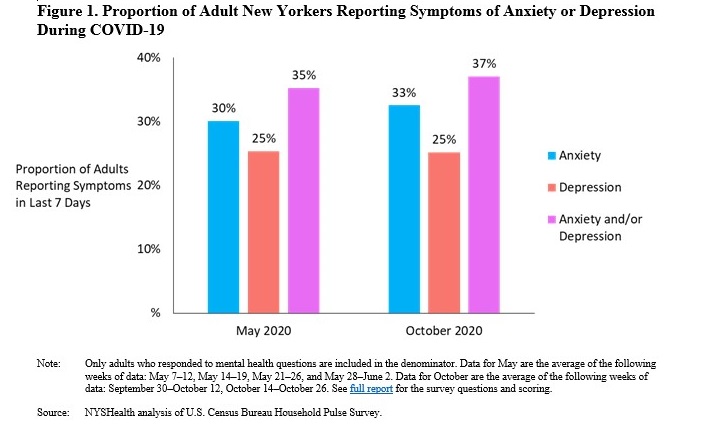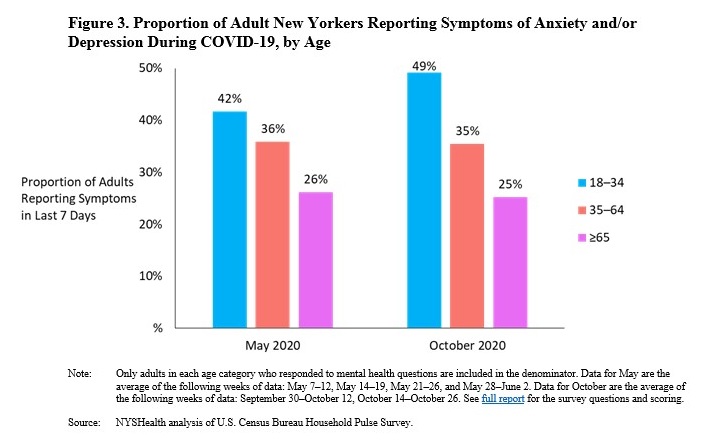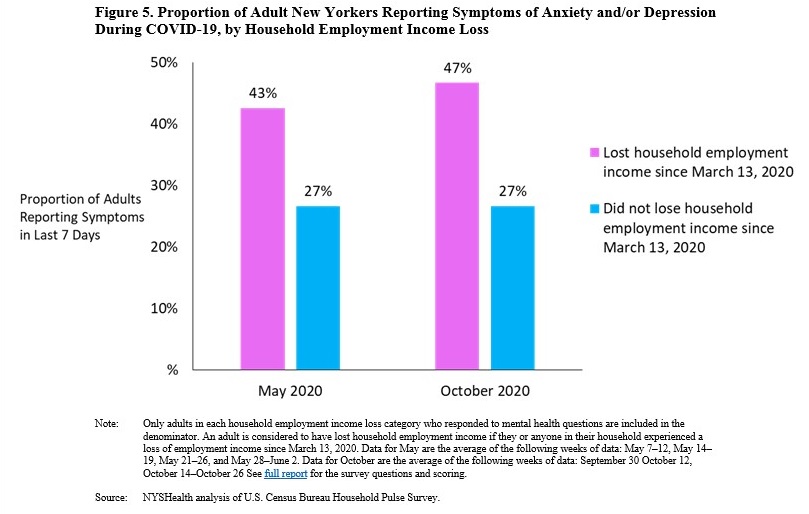The New York City Council Committee on Mental Health, Disabilities, and Addiction held an oversight hearing on the City’s mental health emergency response on February 22, 2021. NYHealth submitted written testimony on the mental health of New Yorkers during the COVID-19 pandemic.
February 24, 2021
Distinguished Members of the Committee on Mental Health, Disabilities, and Addiction:
The New York Health Foundation (NYHealth) appreciates the opportunity to submit written testimony on the status of mental health in New York City. We offer information from our recent research on the mental health impact of the coronavirus pandemic on New Yorkers to highlight priority populations.
A wide body of research shows that people commonly experience fear, anxiety, and stress during and after a disaster.[1],[2] It is not surprising that the coronavirus pandemic is therefore taking a toll on the mental health of New Yorkers. In addition to anxiety about the coronavirus itself, many New Yorkers are struggling with the societal changes resulting from the pandemic, such as isolation from community, uncertainty about the future, or new childcare responsibilities.[3],[4],[5],[6] Furthermore, job loss—experienced by more than 1.7 million people across New York State in April 2020—is associated with anxiety, depression, suicide, and increased substance use. [7],[8],[9],[10],[11] The financial strain caused by this widespread job loss also decreases New Yorkers’ ability to afford mental health care and increases other risk factors for poor mental health. [12],[13]
NYHealth’s Work to Improve Mental Health
NYHealth is a private, independent foundation that works to improve the health of all New Yorkers, especially the most vulnerable. Our grantmaking and research has provided us with experience in and knowledge of mental health needs and services across New York State. In particular, we have supported work to expand access to mental health care via telemedicine and to provide mental health support for frontline workers in the wake of the COVID-19 pandemic.
NYHealth has recently funded multiple projects to bring mental health services to at-risk New Yorkers. For example, NYHealth funded the Headstrong Project and the Military Family Center at NYU Langone Health to expand their telemental health resources for veterans as well as the Stop Soldier Suicide intervention and outreach program to expand the program across the New York City region. NYHealth also supported the Physician Affiliate Group of New York, Bassett Medical Center, and Vibrant Emotional Health to provide mental health training and services to health care workers and other essential workers.[14]
New Research on the Mental Health Impact of COVID-19 in New York State
NYHealth would like to provide the Committee with new research that sheds light on the mental health burden of living through the COVID-19 pandemic in New York State. Although this is a State-level analysis, it can support the City in its continued efforts to design programs and target resources, as well as provide data when working with State and federal partners. Findings highlight growing mental health needs across New York, which may result in mental health crises and the need for a robust community-based mental health emergency response.
The data presented here are from a recently published NYHealth analysis based on the COVID-19 Household Pulse Survey, which is administered by the U.S. Census Bureau in collaboration with multiple federal agencies. The survey provides near real-time data on household experiences, including measures of mental health, during the coronavirus pandemic.
- In May 2020, more than one-third of adult New Yorkers reported symptoms of anxiety and/or depression in the prior week (defined in this analysis as experiencing poor mental health) (see Figure 1). That rate is more than triple what was self-reported nationally using similar measures during recent pre-pandemic periods.[15]
- The proportion of New Yorkers reporting poor mental health has remained high throughout the pandemic, reaching 37% of adult New Yorkers in October 2020 (see Figure 1).
- Compared with all racial and ethnic groups, New Yorkers of color generally reported the highest rates of poor mental health throughout the survey period. In October 2020, 42% of Hispanic and 39% of Black New Yorkers reported symptoms of anxiety and/or depression in the prior week (see Figure 2).
- Although all age groups were affected, in October 2020, young adult New Yorkers (ages 18–34 years) reported the highest rates (49%) of poor mental health (see Figure 3).
- Low-income New Yorkers experienced the highest rates of poor mental health across the survey period, compared with all other income groups. Reported symptoms of anxiety and/or depression increased across all income brackets from May to October 2020 (see Figure 4).
- In October 2020, nearly half of New Yorkers (47%) in households that lost employment income since the start of the pandemic reported symptoms of anxiety and/or depression in the prior week. This rate is 1.7 times higher than among households that did not experience income loss (see Figure 5).
For more details about these findings, please see NYHealth’s full report, available here:
https://nyhealthfoundation.org/resource/mental-health-impact-of-the-coronavirus-pandemic-in-new-york-state
Responding to the Need for Mental Health Services and Mental Health Emergency Response in NYC
Although both New York City and New York State have taken vital steps to increase access to mental health care during the pandemic, more work is required to fulfill unmet needs. In October 2020, approximately 21% of adults in New York State with symptoms of anxiety and/or depression reported that they needed counseling or therapy from a mental health professional in the prior four weeks, but did not get it.[16] Additional services are needed especially in New York City, which is home to a higher proportion of New Yorkers at risk for poor mental health outcomes during the pandemic, including people of color, low-income residents, and families who have recently lost income.
Demand for telemental health services, like mental health hotlines, has soared in New York City during the pandemic. Telemental health has provided a socially distant and safer health care option for many people seeking care throughout the pandemic. It has also helped to bring services remotely to the approximately 2.6 million New York City residents who live in federally designated mental health professional shortage areas, or areas with too few mental health providers and services for a given population.[17]
The need to expand upon existing hotline services is clear. For example, NYC Well—New York City’s support, crisis intervention, and referral service—answered more than 40% more inquiries the first week of April 2020 than it did the first week of January 2020.[18] Demand steadily grew for the rest of the year, with NYC Well answering more than 80% more contacts the first week of November 2020 than it did the first week of January 2020.
Conclusion
NYHealth applauds the Committee for bringing the critical issues of mental health services and mental health emergency response to the forefront during this critical moment. As New Yorkers continue to cope with the ramifications of an enduring pandemic, accessible, affordable, and culturally appropriate services provided by mental health professionals are needed more than ever. We look forward to continuing our partnerships with the City and other organizations to promote the emotional wellbeing of all New Yorkers.
Appendix





[1] Emily Goldmann and Sandro Galea, “Mental Health Consequences of Disasters,” Annual Review of Public Health 35, no. 1 (2014): 169–83, https://doi.org/10.1146/annurev-publhealth-032013-182435.
[2] World Health Organization, “Mental Health and COVID-19,” accessed February 2021, https://www.who.int/teams/mental-health-and-substance-use/covid-19.
[3] Christoph Benke et al., “Lockdown, Quarantine Measures, and Social Distancing: Associations with Depression, Anxiety and Distress at the Beginning of the COVID-19 Pandemic among Adults from Germany,” Psychiatry Research 293 (November 2020): 113462, https://doi.org/10.1016/j.psychres.2020.113462.
[4] Samantha K Brooks et al., “The Psychological Impact of Quarantine and How to Reduce It: Rapid Review of the Evidence,” The Lancet 395, no. 10227 (March 2020): 912–20, https://doi.org/10.1016/S0140-6736(20)30460-8.
[5] N. Leigh-Hunt et al., “An Overview of Systematic Reviews on the Public Health Consequences of Social Isolation and Loneliness,” Public Health 152 (November 2017): 157–71, https://doi.org/10.1016/j.puhe.2017.07.035.
[6] June Gruber et al., “Mental Health and Clinical Psychological Science in the Time of COVID-19: Challenges, Opportunities, and a Call to Action,” American Psychologist, August 10, 2020, https://doi.org/10.1037/amp0000707.
[7] New York State Department of Labor, “NYS Economy Loses More Than 1.7 Million Private Sector Jobs in April 2020,” May 21, 2020, https://www.labor.ny.gov/pressreleases/2020/may-21-2020.shtm.
[8] Jessamyn Schaller and Ann Huff Stevens, “Short-Run Effects of Job Loss on Health Conditions, Health Insurance, and Health Care Utilization,” Journal of Health Economics 43 (September 2015): 190–203, https://doi.org/10.1016/j.jhealeco.2015.07.003.
[9] Stephanie Pappas, “The Toll of Job Loss,” Monitor on Psychology 51, no. 7 (October 1, 2020), https://www.apa.org/monitor/2020/10/toll-job-loss.
[10] Aaron Reeves, Martin McKee, and David Stuckler, “Economic Suicides in the Great Recession in Europe and North America,” The British Journal of Psychiatry: The Journal of Mental Science 205, no. 3 (September 2014): 246–47, https://doi.org/10.1192/bjp.bp.114.144766.
[11] Gera E. Nagelhout et al., “How Economic Recessions and Unemployment Affect Illegal Drug Use: A Systematic Realist Literature Review,” International Journal of Drug Policy 44 (June 1, 2017): 69–83, https://doi.org/10.1016/j.drugpo.2017.03.013.
[12] Patience A. Afulani, Alisha Coleman-Jensen, and Dena Herman, “Food Insecurity, Mental Health, and Use of Mental Health Services among Nonelderly Adults in the United States,” Journal of Hunger & Environmental Nutrition 15, no. 1 (January 2, 2020): 29–50, https://doi.org/10.1080/19320248.2018.1537868.
[13] Lauren Taylor, “Housing And Health: An Overview Of The Literature,” Health Affairs, June 7, 2018, https://doi.org/10.1377/hpb20180313.396577.
[14] NYHealth, “COVID-19 Response and Relief Efforts,” New York Health Foundation, accessed February 24, 2021, https://nyhealthfoundation.org/grantee/covid-19-response-and-relief-efforts/.
[15] National Center for Health Statistics, “Early Release of Selected Mental Health Estimates Based on Data from the January–June 2019 National Health Interview Survey,” May 2020, https://www.cdc.gov/nchs/data/nhis/earlyrelease/ERmentalhealth-508.pdf.
[16] NYHealth analysis of U.S. Census Bureau Household Pulse Survey.
[17] Mayor’s Office of ThriveNYC, “Redesigned Mental Health Service Corps Launches, Bringing More Mental Health Support to Historically Underserved Neighborhoods across New York City,” January 31, 2020, https://thrivenyc.cityofnewyork.us/news/announcements/redesigned-mental-health-service-corps-launches-bringing-more-mental-health-support-to-historically-underserved-neighborhoods-across-new-york-city-2.
[18] NYC Well administrative data, obtained via FOIL request from NYC Department of Health and Mental Hygiene, received January 2021.

